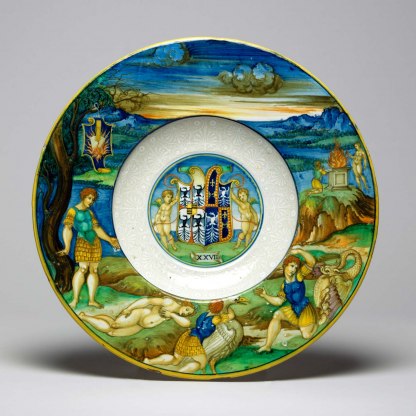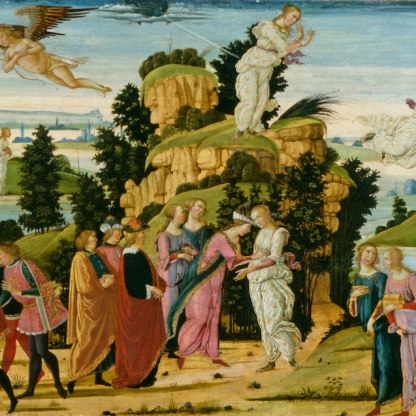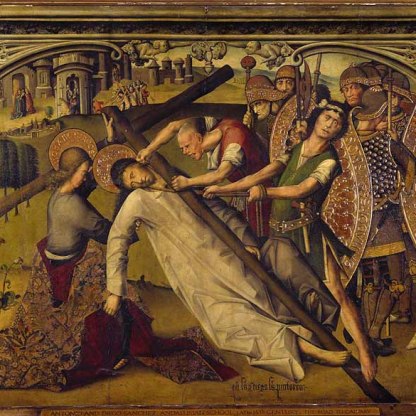Maiolica dish

This dish is part of a spectacular dinner service created for Isabella d'Este, Marchesa of Mantua and one of the greatest patrons and collectors of Renaissance Italy.
Twenty similar examples survive, all of them exquisitely decorated with scenes from history, mythology or the Bible. Maiolica – tin-glazed earthenware – decorated in this way was called istoriato: literally 'storied'. The colourful decorations, which did not fade with age, greatly increased its value. This, along with their literary subject matter, meant that istoriato wares appealed to wealthy and educated patrons like Isabella in a way that earlier, simpler ceramics never had.
The myth shown here is adapted from Ovid's Metamorphoses. On the left, the Greek hero Peleus stands above the sleeping sea-nymph, Thetis, in an attitude of admiration and surprise.
After he has leapt lustfully upon her, Thetis turns herself first into a swan (detail, left) and then into a dragon (right) to shake off his unwanted embrace.
Finally repulsed, Peleus retires to pray at an altar where he receives divine guidance, from a naked goddess.
For the basic elements of his composition, the celebrated painter of maiolica, Nicola da Urbino, has followed a woodcut illustration from a 1497 paraphrase of Ovid's poem. An edition from 1505 in the Fitzwilliam Library (left) shows the debt that the d'Este plate owes to this publication. But Nicola's brilliant use of colour, the fluency of his figures, and the beautifully realised landscape against which the episodes take place, transcend this simple book illustration.
As well as providing an attractive and entertaining narrative, the plate also commemorates the union of two powerful northern Italian dynasties: the marriage of Isabella, daughter of the duke of Ferrara, to Gianfrancesco Gonzaga, Marquis of Mantua. In the very centre of the plate two putti support a shield which shows the arms of the Gonzaga family 'impaling' those of Este: two halves of each coat of arms are placed side by side, the husband's on the right, the wife's on the left, divided by a thin line, or pale.
Two other devices confirm the identity of the dish's original owner. Isabella, like many aristocrats and intellectuals in the Renaissance, adopted personal imprese – emblems. These were often accompanied by a motto, expressing a deeply held belief or commemorating an event of significance in the life of the owner. Prominent beneath the central shield here is a painted scroll bearing the Roman numerals XXVII. In Italian, the number 27 – vente sette – sounds like vinti siete – 'you are defeated' – a defiant motto that suggests that Isabella had overcome opponents.
On a shield hanging from the tree on the left, a bundle of gold rods are shown standing upright in a crucible, licked by flames. The image was adopted by Gianfancesco Gonzaga in 1495, and was accompanied by the Latin motto 'probasti me domine et cognovisti me' – 'you have tested me, Lord, and you have known me'. It commemorates Gonzaga's being absolved of blame for allowing the French army to escape after their defeat at the battle of Fornovo in 1495.
Themes and periods
Data from our collections database
Maiolica dish, painted in polychrome with, in the well, the arms of Gonzaga impaling Este, and, on the rim, Peleus and Thetis.
Earthenware, tin-glazed overall; the reverse pale beige and speckled. Painted in blue, green, yellow, orange, stone, brown, manganese-purple, black, and white. Shape 56 (Poole 1995). circular with broad, almost flat rim, and deep well; the underside of the rim moulded with three bands of reeding.In the well, within narrow blue and yellow concentric circles, two putti support a shield charged with the arms of Gonzaga impaling Este: argent, a cross patty gules cantoned by four eagles displayed sable (Gonzaga modern granted 1433), an escutcheon overall, quarterly, 1, 4, gules a lion rampant argent (Bohemia), 2, 3, barry of six or and sable (Gonzaga ancient) impaling Este, quarterly, 1, 4, azure three fleurs-de-lis or a bordure indented gules, 2, 3, azure an eagle displayed argent (gules shown orange throughout). Below on a scroll is the impresa `XXVII'. The sides are decorated in bianco sopra bianco with palmettes and scrolls, and a blue line encircles the shoulder. The rim is decorated with Peleus and Thetis. Peleus stands beneath a tree, gazing at Thetis, who sleeps nude on the ground in front of him. Further to the right she is transformed into a swan-like bird as he embraces her, and then into a dragon from which he turns away in horror. Higher up on the right, a goddess appears to Peleus who kneels before an altar. In the distance there is a mountainous landscape and sky. Suspended from the tree there is a shield of testa di cavallo form charged with the impresa of gold rods in a crucible surrounded by flames in a blue ground. The edge is yellow. On the back there is a narrow yellow band round the base and a wider band on the edge.
A member of the Rothschild family, Paris; Charles Damiron, Lyon; Sotheby's, 16 June 1938, Catalogue of the very choice collection of old Italian maiolica and Hispano-Moresque ware the property of Monsieur Damiron, 8 vue Vaubecour, Lyons, p. 63, lot 63.
Legal notes
Purchased with the Glaisher fund
Acquisition and important dates
- Method of acquisition: Bought
- Dates: 1938-06-16
Dating
The potter, Nicola di Gabriele Sbraghe, known as Nicola da Urbino, was a workshop owner in Urbino from at least 1520 until his death at the end of 1537 or in January 1538. He was also a brilliant maiolica painter, whose work has been identified by comparison with five pieces of istoriato maiolica monogrammed or signed by him. Nicola painted in an exquisitely delicate manner, and was unusually imaginative in his adaptation of printed sources and in the creation of architectural and landscape backgrounds. His output of the 1520s, which includes several armorial services, is regarded as the acme of maiolica decoration.
This exquisite dish formed part of a service which belonged to Isabella d'Este (1474-1539), widow of Francesco Gonzaga, fourth Marchese of Mantua (1466-1519). It was made between 1522 and 1525, and may have been the service given to Isabella probably in November 1524 by her daughter, Eleanora, Duchess of Urbino, who thought that she might like to use it in her villa at Porto near Mantua. Twenty-two dishes and one fragmentary dish are known, two decorated with biblical scenes and the rest with subjects from classical mythology or history. Each dish also bears the arms of Gonzaga impaling Este, and one or more of Isabella's imprese (a device or emblem) or her initials YS intertwined. On this dish the arms are surrounded by bianco sopra bianco decoration, and the rim is decorated with the story of Peleus and Thetis from Ovid's Metamorphoses, Book XI. Having found the sea goddess Thetis asleep on the shore, Peleus entreated her to make love, but she refused and escaped by transforming herself into different forms. After praying to the sea god Proteus for advice, Peleus successfully overcame the goddess's scruples and she conceived the ill-fated hero, Achilles. Nicola based the figures on a woodcut illustration in Giovanni dei Bonsignori's Ovidio methamorphoseos vulgare, Venice (Giovanni Rosso da Vercelli for Lucantonio Giunta), 1497 or a later edition. Two imprese are shown: `XXVII' sounding like vinti sète, (you are defeated), and gold bars in a crucible, which Isabella's husband adopted in 1495 to signify his integrity after successfully withstanding an accusation of treachery.
Maker(s)
Note
The potter, Nicola di Gabriele Sbraghe, known as Nicola da Urbino, was a workshop owner in Urbino from at least 1520 until his death at the end of 1537 or in January 1538. He was also a brilliant maiolica painter, whose work has been identified by comparison with five pieces of istoriato maiolica monogrammed or signed by him. Nicola painted in an exquisitely delicate manner, and was unusually imaginative in his adaptation of printed sources and in the creation of architectural and landscape backgrounds. His output of the 1520s, which includes several armorial services, is regarded as the acme of maiolica decoration.
This exquisite dish formed part of a service which belonged to Isabella d'Este (1474-1539), widow of Francesco Gonzaga, fourth Marchese of Mantua (1466-1519). It was made between 1522 and 1525, and may have been the service given to Isabella probably in November 1524 by her daughter, Eleanora, Duchess of Urbino, who thought that she might like to use it in her villa at Porto near Mantua. Twenty-two dishes and one fragmentary dish are known, two decorated with biblical scenes and the rest with subjects from classical mythology or history. Each dish also bears the arms of Gonzaga impaling Este, and one or more of Isabella's imprese (a device or emblem) or her initials YS intertwined. On this dish the arms are surrounded by bianco sopra bianco decoration, and the rim is decorated with the story of Peleus and Thetis from Ovid's Metamorphoses, Book XI. Having found the sea goddess Thetis asleep on the shore, Peleus entreated her to make love, but she refused and escaped by transforming herself into different forms. After praying to the sea god Proteus for advice, Peleus successfully overcame the goddess's scruples and she conceived the ill-fated hero, Achilles. Nicola based the figures on a woodcut illustration in Giovanni dei Bonsignori's Ovidio methamorphoseos vulgare, Venice (Giovanni Rosso da Vercelli for Lucantonio Giunta), 1497 or a later edition. Two imprese are shown: `XXVII' sounding like vinti sète, (you are defeated), and gold bars in a crucible, which Isabella's husband adopted in 1495 to signify his integrity after successfully withstanding an accusation of treachery.
Place(s) associated
- Urbino
Materials used in production
Read more about this recordStories, Contexts and Themes
Other highlight objects you might like
Suggested Curating Cambridge products
Sign up to our emails
Be the first to hear about our news, exhibitions, events and more…







